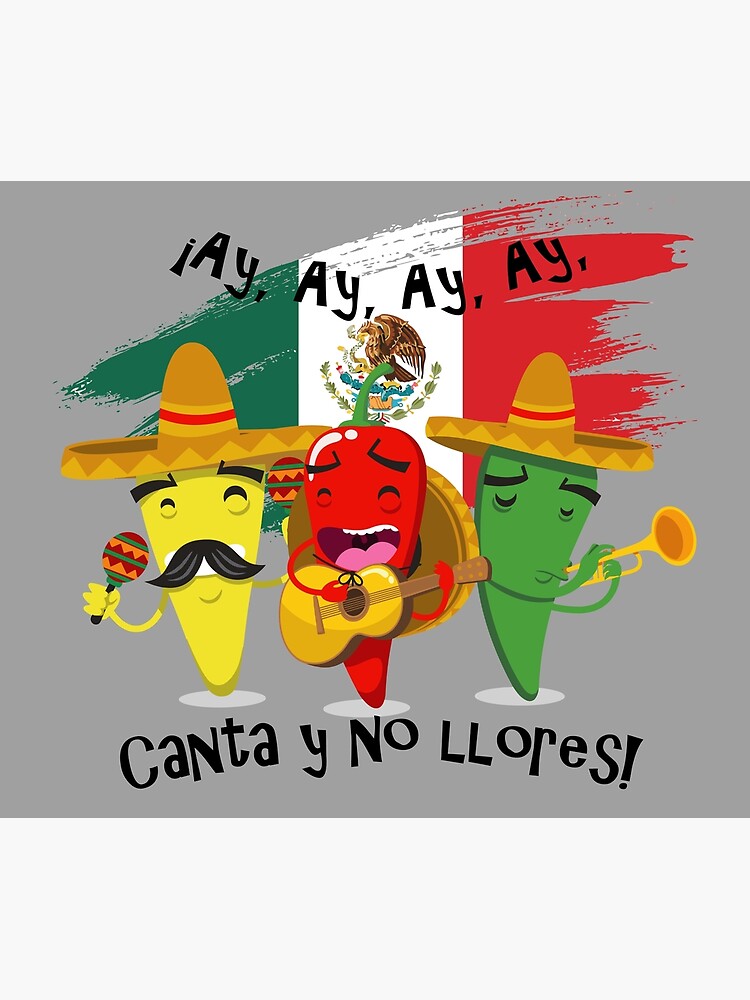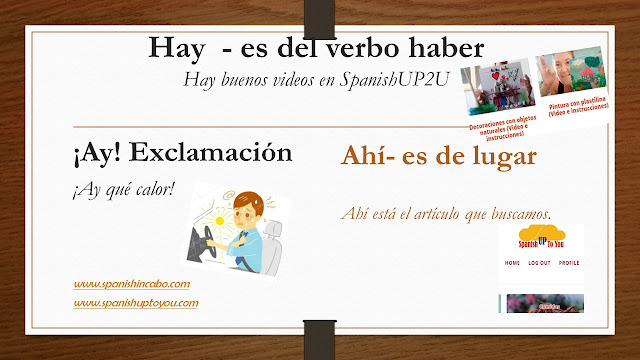5 minutos de español : ¡Ay!, hay o ahí ¿Cuándo uso uno u otro? / When do I use one or the other? / 5 minute of Spanish -English & Spanish version -Podcast
 |
| ¡Ay!¡ me duele la cabeza! |
How are you? Good
morning, good afternoon or good evening, depending on where you are or what
time you are listening to us. In these 5 minutes of Spanish in the middle of
the week we are going to talk about 3 little words that get confused because they
are pronounced the same but have a totally different meaning.
It is a common mistake not only for Spanish learners
but also for native speakers.
Let's study the
difference between ay, hay and ahí.
Ay,
without hache at the beginning is an exclamation, which occurs when someone
feels pain.
For example, you hit
yourself and you say: ay!
Sometimes you say other things but these are
for another 5 minutes.
Puede ser también una queja (complain)-Could be a
complain
¡Ay! ¡Me duele la
cabeza, voy a descansar un poco!
My head hurts,
I'm going to rest for a while!
¡Ay!, no puedo dormir
bien, me molesta el ladrido de los perros.
Ouch, I can't
sleep well, the dogs' barking bothers me.
¡Ay! Y también tenemos
una canción que dice así: / We have also a song
Ay, ay ay ay…..canta y
no llores.
Ay, ay ay ay…..canta y
no llores.
¡Por favor no cantes Malena! /Pleas, don´t sing!!
Well, you limit
my creativity, we are going to "Hay", but in this case the word does
begin with "h", it is an impersonal form of the verb “haber” and is
used to express existence.
Hay una farmacia en
esta cuadra
There is a
pharmacy on this block
Hay muchas playas
maravillosas en Los Cabos.
There are many
wonderful beaches in Los Cabos.
¿Hay un parque de
diversiones en Los Cabos?
Is there an
amusement park in Los Cabos?
Also, we can
use “hay que” with the plan sor task to do, impersonal way.
Hay que arreglar esta biblioteca.
This library
needs to be fixed
Hay que cambiar las
luces en esta colonia.
The lights need
to be changed in this neighborhood.
Hay que leer el cuento
para el taller de lectura de SpanishUp2U
The story for
the SpanishUp2U reading workshop needs to be read.
Ahí (there),
it is written with the "hache" in the middle of the "a" and
the "i", and the accent is placed on the "í".
It is an adverb that
indicates the location of something.
El celular está ahí.
The cell phone
is there.
La niña dejó su
juguete ahí y se fue a jugar allí con el perro.
The little girl
left her toy there and went to play there with the dog.
There it indicates a
little more distance from the person speaking.
They can also be
combined, as in this case:
·
¿Vamos a comer con
amigos?
·
¡Ay! Sí, ¡qué bueno! ¿Adónde vamos?
·
Ahí hay un restaurante
de mariscos y allí uno de pastas, ¿cuál prefieres?
·
¡Ay! Pero a mi amiga le encanta el mole, ¿qué hacemos?
·
Ahí adelante hay un restaurante
mexicano, se llama Allá en el Rancho Grande.
·
Entonces, vamos
ahí.
·
Sí, querida
Oh, we went out with
the yes dear again...
So if you have doubts
just think about where the h goes or if it has h in it.
If it is at the
beginning, it is hay of the verb haber, we are talking about existence.
If it is in the middle
and is accented: ahí, it is an adverb of place.
If it does not have h
and it is with exclamation marks, it is an exclamation.
Thank you very much for
making it this far in the podcast, if you liked it share it with your friends.
And if you want to
practice more Spanish there are places available at SpanishUp2U or Spanish in
Cabo classes.
Are the online groups
too big?
No, they are very small or you have the option
of one on one classes and excellent teachers, of course.
Remember, a very good
way to improve your Spanish is by listening and participating in the activities
on our new site: SpanishUP2U.
See you soon
Bye, bye
Spanish version
¿Qué tal? Buenos días,
buenas tardes o buenas noches, según el lugar en donde estés o a la hora en la
que nos escuches. En estos 5 minutos de español a la mitad de la semana vamos a
hablar de 3 pequeñas palabras que se confunden pues se pronuncian igual pero
tienen un significado totalmente diferente.
Suele ser un error bastante común no sólo, para los
estudiantes de español sino también, para los nativos.
Vamos a estudiar la
diferencia entre ay, hay y ahí.
Ay, sin hache al
principio es una exclamación, que ocurre cuando alguien siente dolor.
Por ejemplo, te
golpeas y dices: ¡ay!
A veces dices
otras cosas pero estas son para otros 5 minutos.
Puede ser también una queja (complain)
¡Ay! ¡Me duele la
cabeza, voy a descansar un poco!
My head hurts,
I'm going to rest for a while!
¡Ay!, no puedo dormir
bien, me molesta el ladrido de los perros.
Ouch, I can't
sleep well, the dogs' barking bothers me.
¡Ay! Y también tenemos una canción que dice así:
Ay, ay ay ay…..canta y
no llores.
Ay, ay ay ay…..canta y
no llores.
¡Por favor no cantes Malena!
Bien, me limitan la
creatividad, nos vamos a “Hay”, pero en este caso la palabra, sí empieza con
“h”, es una forma impersonal del verbo haber y
se usa para expresar existencia.
Hay una farmacia en
esta cuadra
There is a
pharmacy on this block
Hay muchas playas
maravillosas en Los Cabos.
There are many
wonderful beaches in Los Cabos.
¿Hay un parque de
diversiones en Los Cabos?
Is there an
amusement park in Los Cabos?
También se puede usar “hay que” con los planes o
tareas para hacer, en forma impersonal:
Hay que arreglar esta biblioteca.
This library
needs to be fixed
Hay que cambiar las
luces en esta colonia.
The lights need
to be changed in this neighborhood.
Hay que leer el cuento
para el taller de lectura de SpanishUp2U
The story for
the SpanishUp2U reading workshop needs to be read.
Ahí, se escribe con la
hache en el medio de la a y de la i, además se pone acento en la í.
Es un adverbio que
señala la ubicación de alguna cosa.
El celular está ahí.
The cell phone
is there.
La niña dejó su
juguete ahí y se fue a jugar allí con el perro.
The little girl
left her toy there and went to play there with the dog.
Allí indica un poco
más de distancia respecto a la persona que habla.
También se pueden
combinar, cómo en este caso:
¿Vamos a comer con amigos?
¡Ay! Sí, ¡qué bueno!
¿Adónde vamos?
Ahí hay un restaurante de mariscos y allí uno de
pastas, ¿cuál prefieres?
¡Ay! Pero a mi amiga
le encanta el mole, ¿qué hacemos?
Ahí adelante hay un restaurante mexicano, se llama
Allá en el Rancho Grande.
Entonces, vamos ahí.
Sí, querida
¡Ay! Salimos con el sí
querida otra vez…
O sea que si tienes dudas solo pensar en dónde va la h
o si lleva h.
Si va al principio es hay del verbo haber, hablamos de
existencia.
Si está en el medio y se acentúa: ahí, es un adverbio
de lugar
Si no lleva h y está con signos de exclamación es una
exclamación.
Muchas gracias por
llegar hasta aquí en el podcast, si te gustó compártelo con tus amigos.
Y si quieres practicar más español hay lugares
disponibles en SpanishUp2U o en las
clases de Spanish in Cabo.
¿Son muy grandes los
grupos online?
No, son muy
pequeños o tienes la opción de clases uno a uno y excelentes profesores, claro.
¡Ay! Recuerda, una muy
buena forma de mejorar el español es escuchando y participando en las
actividades de nuestro nuevo sitio: https://spanishuptoyou.com/
Hasta pronto
Chau,chau




Comentarios
Publicar un comentario